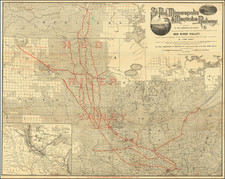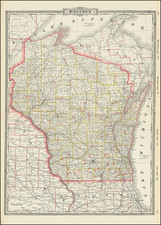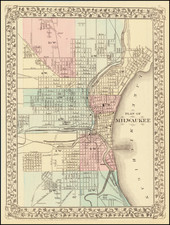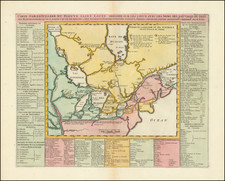Rare Wisconsin Birdseye View
Rare separately issued view of the city of Superior, Wisconsin, published during Superior's second boom period (1888 to 1892).
Shows railroads, railroad yards, main roads, additions, and selected buildings in Superior and parts of the Towns of Superior, Parkland, and Lakeside.
In the nineteenth century, spurred by the prospect of lucrative shipping on the Great Lakes and exploitation of the iron ore industry, businessmen from Chicago and St. Paul, Minnesota laid claim to the site which became the city of Superior.
The first log cabin in Superior was erected in September 1853 on the banks of the Nemadji River, at the same time that ground was broken for construction of the locks and ship canal at Sault Ste. Marie, Michigan. This was intended to allow ships to bypass the rapids at that site. Superior was incorporated as a city on September 6, 1854. Around the same time Superior became the seat of newly formed Douglas County. While initially settlers moved to the new town, the Panic of 1857 saw the population fall from 2500 to 500.
In 1882, the Northern Pacific Railway and other rail lines finally arrived, fulfilling the dream of a rail and water highway from coast to coast. In 1883, General John H. Hammond formed the Land and River Improvement Company, which developed much of West Superior, including the West Superior Iron and Steel plant. Numerous grain, coal and lumber businesses formed in the same period.
In the boom period from 1888 to 1892, Land and River Improvement and others built impressive architect-designed business blocks on Tower Avenue, seeing Superior as the "new Chicago." By 1892, population was 34,000.
Hallock-Harmon-Leader was a printer in Superior, Wisconsin and likely issued this version of the view as a promotional item.
Rarity
The view is extremely rare. The Library of Congress and Penn State hold a variant edition without the credit to Hallock-Harmon-Leader & Co., which may include printed color.
It would also appear that an example of this state of the view is part of a 16 page manuscript by Charles A. Pillsbury entitled Mills at the head of the lakes : with general description and detail information, which is held by the Minnesota Historical Society.










![Milwaukee City and Environs Engraved expressly to accompany the City Directory for 1858 & 9. [with:] Milwaukee City Directory. 1858-9.](https://storage.googleapis.com/raremaps/img/small/57977.jpg)
![Barnes' Addition to Superior [Wisconsin]](https://storage.googleapis.com/raremaps/img/small/84806.jpg)


